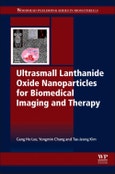Most books discuss general and broad topics regarding molecular imagings. However, Ultrasmall Lanthanide Oxide Nanoparticles for Biomedical Imaging and Therapy, will mainly focus on lanthanide oxide nanoparticles for molecular imaging and therapeutics. Multi-modal imaging capabilities will discussed, along with up-converting FI by using lanthanide oxide nanoparticles. The synthesis will cover polyol synthesis of lanthanide oxide nanoparticles, Surface coatings with biocompatible and hydrophilic ligands will be discussed and TEM images and dynamic light scattering (DLS) patterns will be provided. Various techniques which are generally used in analyzing the synthesized surface coated nanoparticles will be explored and this section will also cover FT, IR analysis, XRD analysis, SQUID analysis, cytotoxicity measurements and proton relaxivity measurements. In vivo MR images, CT images, fluorescence images will be provided and Therapeutic application of gadolinium oxide nanoparticles will be discussed. Finally, future perpectives will be discussed. That is, present status and future works needed for clinical applications of lanthanide oxide nanoparticles to molecular imagings will be discussed.
Table of Contents
Introduction
Synthesis
Characterizations
What is MRI and CT
MRI contrast agent
CT contrast agent
Multimodal imaging agents
Therapeutics
Future perspectives
References








